This post may contain affiliate links. Learn more.
Kale juice should taste as good as it makes you feel. This recipe strikes a pleasing chord with well-balanced sweet, tart, spicy, and earthy flavors.
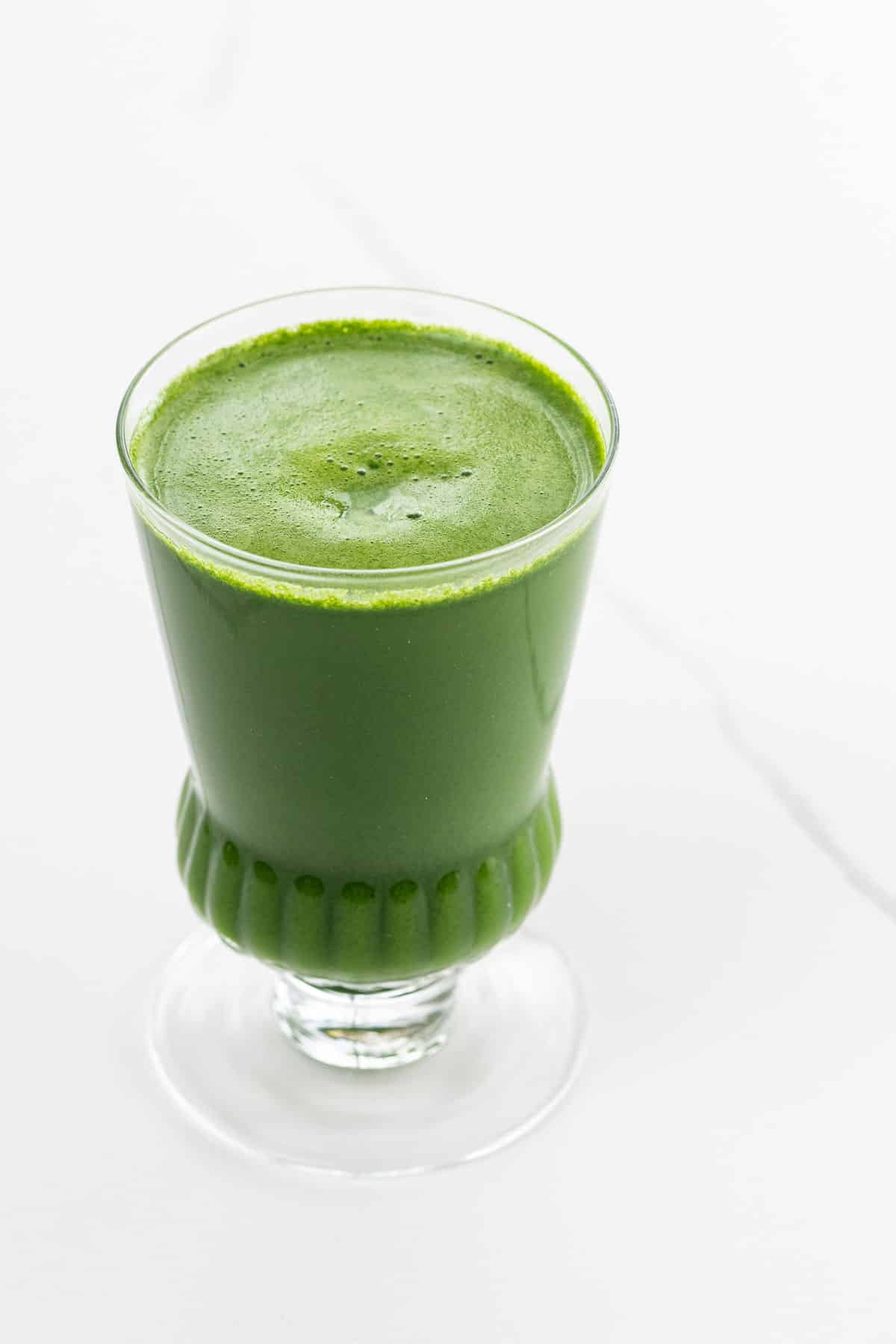
Why we love this recipe
I’ve made a lot of green juice and developed a lot of recipes since I got my first juicer in 2012, and this beautifully balanced, slightly sophisticated kale juice was one of the first. I drank it daily for a long time, and I still love it. It’s:
- Packed with nutrients
- Easy to make in any juicer
- Full of balanced, vibrant flavors
- Fresh and fabulous
I first published this recipe here and in my Serious Eats column way back in 2013. I’ve since updated the post for clarity and altered the quantities in the recipe to serve one person.
What you’ll need
Here’s a glance at the ingredients you’ll need to make this recipe.
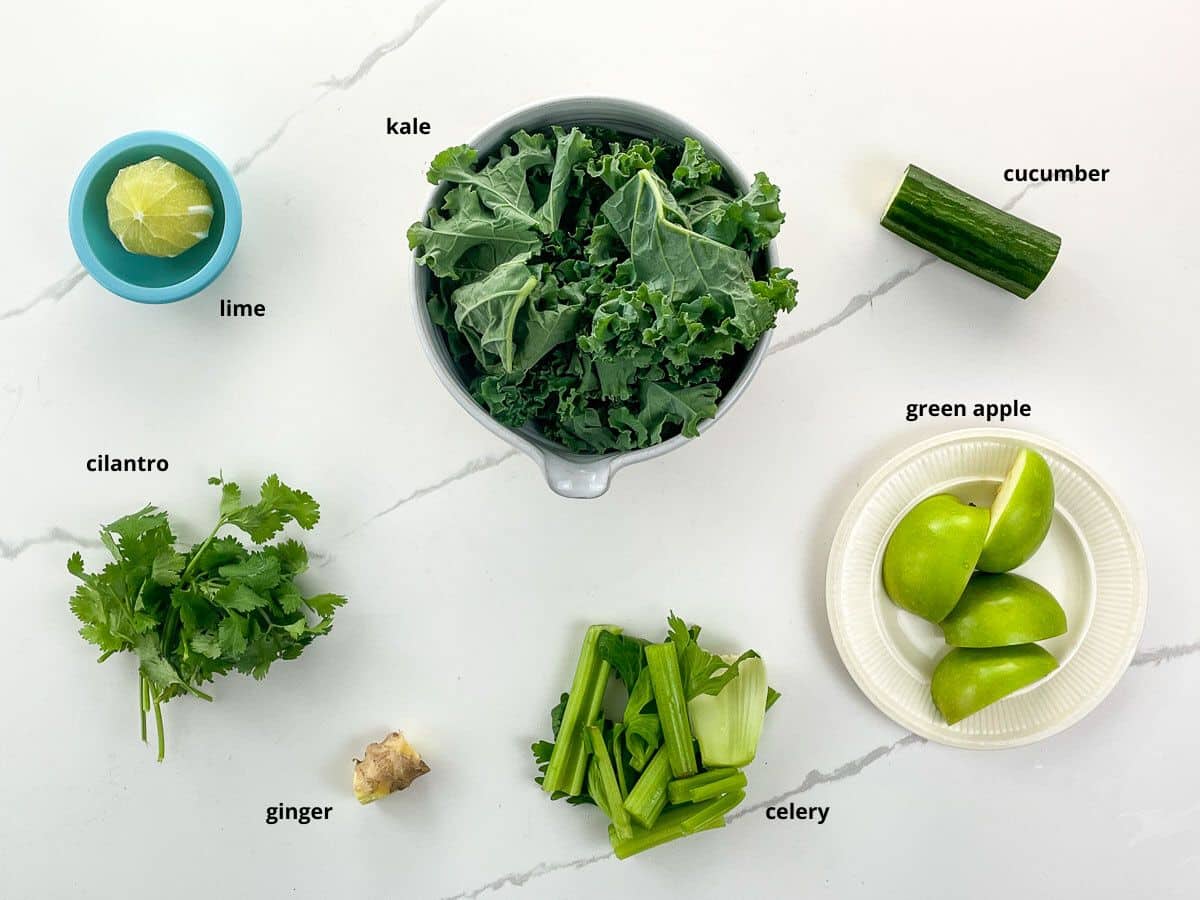
- Green curly kale tends to have a fairly mild flavor, and it produces quite a bit of juice. You’ll use two large leaves, including the stems.
- A tart green apple (such as Granny Smith) is one of my favorite green juice ingredients. It adds a bit of complex sweetness and tartness that complements virtually all juices, while keeping things relatively low-glycemic. You don’t need to peel it. The rest of the prep depends on your juicer — see manufacturer’s instructions for best results.
- Cucumber is an easy choice for juicing. I like to use unwaxed varieties so I can include the skin. English and Persian cucumbers are good bets, as in anything from the garden or farmers’ market.
- Cilantro has a lot of health benefits and also packs a flavor punch. I love what it adds to this juice. If you don’t like it, you can substitute parsley.
- Ginger is a great inflammation-buster and adds a fiery freshness to the flavor profile. If you’re not a fan, you can leave it out.
- Celery is an absolute workhorse of green juice. It has a mild, pleasant flavor and contributes a ton of volume. Put it through the juicer last to flush out any remaining goodness from the other fruits and veggies.
- Lime adds an element of tanginess and freshness. You’ll use a knife to cut off the peel and white pith and then put the rest of it through the juicer.
How to make it
You’ll get to know the ins and outs of your individual juicer and how it processes fruits and veggies simply by using it. But here’s an overview of what you’ll do to make a great glass of kale juice, regardless of your juicer. You can see the steps in action in the video that accompanies this post, and get all the details in the recipe card below.
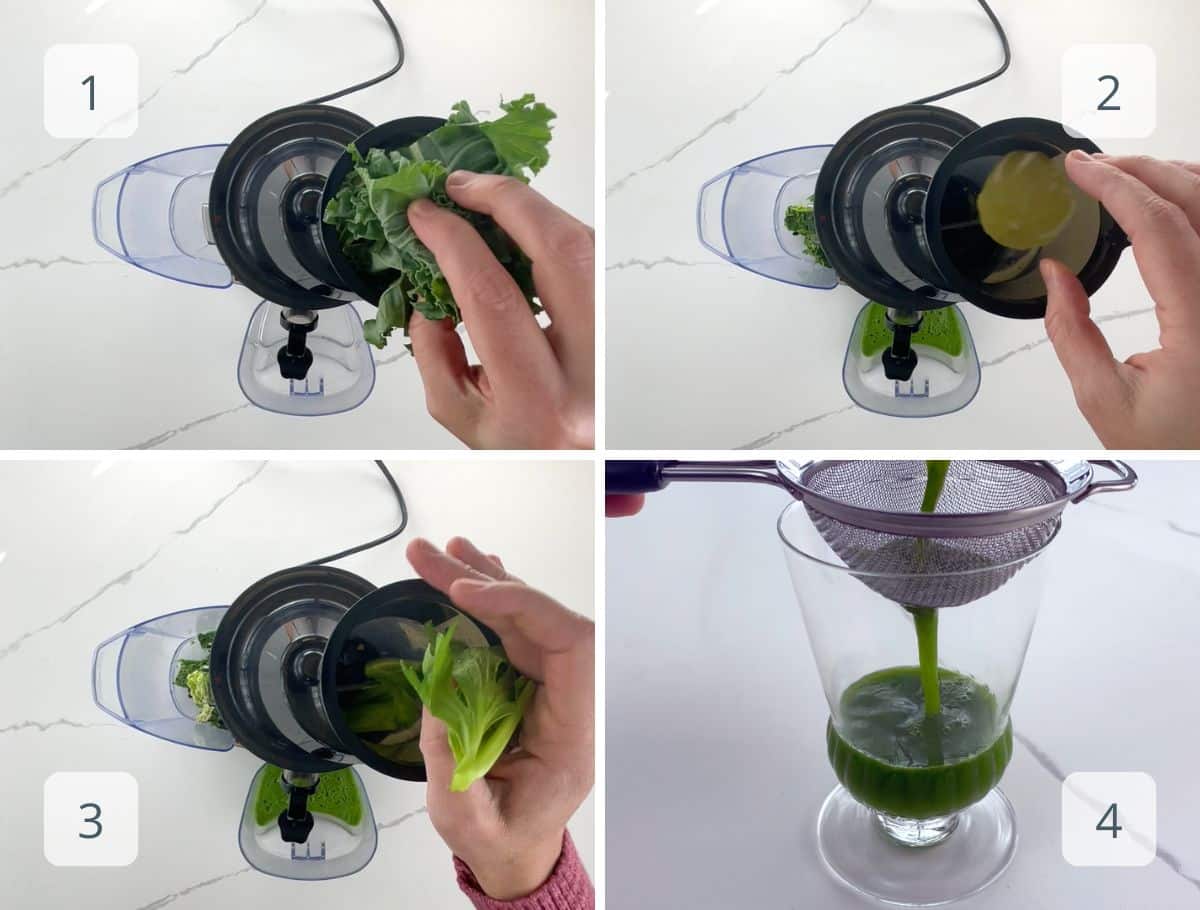
- Start by feeding the leafy ingredients through the juicer. The kale and cilantro will probably want a little help from the plunger to get rolling through the machine.
- Add the remaining ingredients in the order suggested in the recipe card below.
- Finish with the celery, which is super-juicy and helps flush the rest of the ingredients through the juicer.
- Strain into a glass and serve. That’s it!
Best practices for making fresh juice
- Buy organic produce for juicing when possible, since juice is a concentrated source of everything its ingredients contain, including nutrients and pesticides.
- How you’ll prep your produce depends on the individual juicer. In general, always remove peel and pith from citrus, wash vegetables well to remove any dirt, and trim any really gnarly ends from produce. Beyond that, follow the manufacturer’s instructions.
- Juice the ingredients in the order listed to maximize yield. Finishing with a very juicy ingredient like celery helps to flush more stubborn ingredients like ginger through the juicer.
- A note for centrifugal juicers: When juicing leafy greens and herbs, you’ll get a better yield if you tightly pack the greens (roll them up before adding to the feed tube of your juicer) and place them between two harder, juicier ingredients (such as cucumber and apple). Nudge the greens through the juicer one small push at a time.
- If your juicer has multiple speeds, use a slower speed for softer ingredients like leafy greens, soft herbs, and citrus.
- Keep in mind that juicers vary a lot in terms of design and yield, so your mileage may vary. Over time you’ll learn what works best for you.
Expert tips and FAQs
For many years, I’ve used the Kuvings Whole Slow Juicer. It’s a masticating juicer (which I will remind you means CHEWING, you perv), so named to my great chagrin because it kinda chews up your fruits and vegetables before sending the juice through a strainer. This method does a good job preserving nutrients for a longer period of time and minimizing oxidation.
Before that, I used an earlier version of the Breville Juice Fountain, which is an excellent centrifugal juicer. This method wins the award for least terrible name, but it causes more oxidation, so the nutrients in your juice won’t last as long.
Both kinds of juicers are totally great if you’d like to drink your fresh juice right away, but masticating juicers are better at preserving nutrients for up to a few days, in case you like to juice in batches.
As noted above, the nutrient retention in fresh juice has a lot to do with what kind of juicer you’re using. If you have a centrifugal juicer, it’s best to drink your juice fairly soon after you make it. With a masticating juicer, feel free to juice in larger batches. They’ll keep well in an airtight container in the fridge (such as a quart-sized mason jar) for two to three days.
Juice can be frozen for longer storage, but you’ll find that any remaining solid bits fall out of suspension and sink to the bottom after defrosting. I’m not personally a huge fan of the texture of defrosted juice, but if you’re okay with it, freezing can be a good bet.
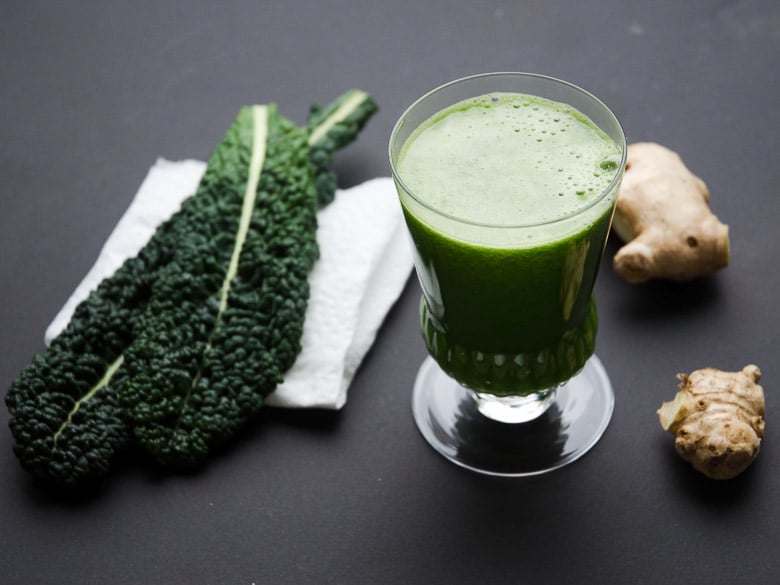
More green juice resources
Whether you’re new to juicing or want to get next-level, I recommend reading my thorough post on Juicing for Beginners. It has all my best tips, tricks, and resources for your juicing regimen, whatever you’d like it to be.
And here are a few more favorite green juice recipes:
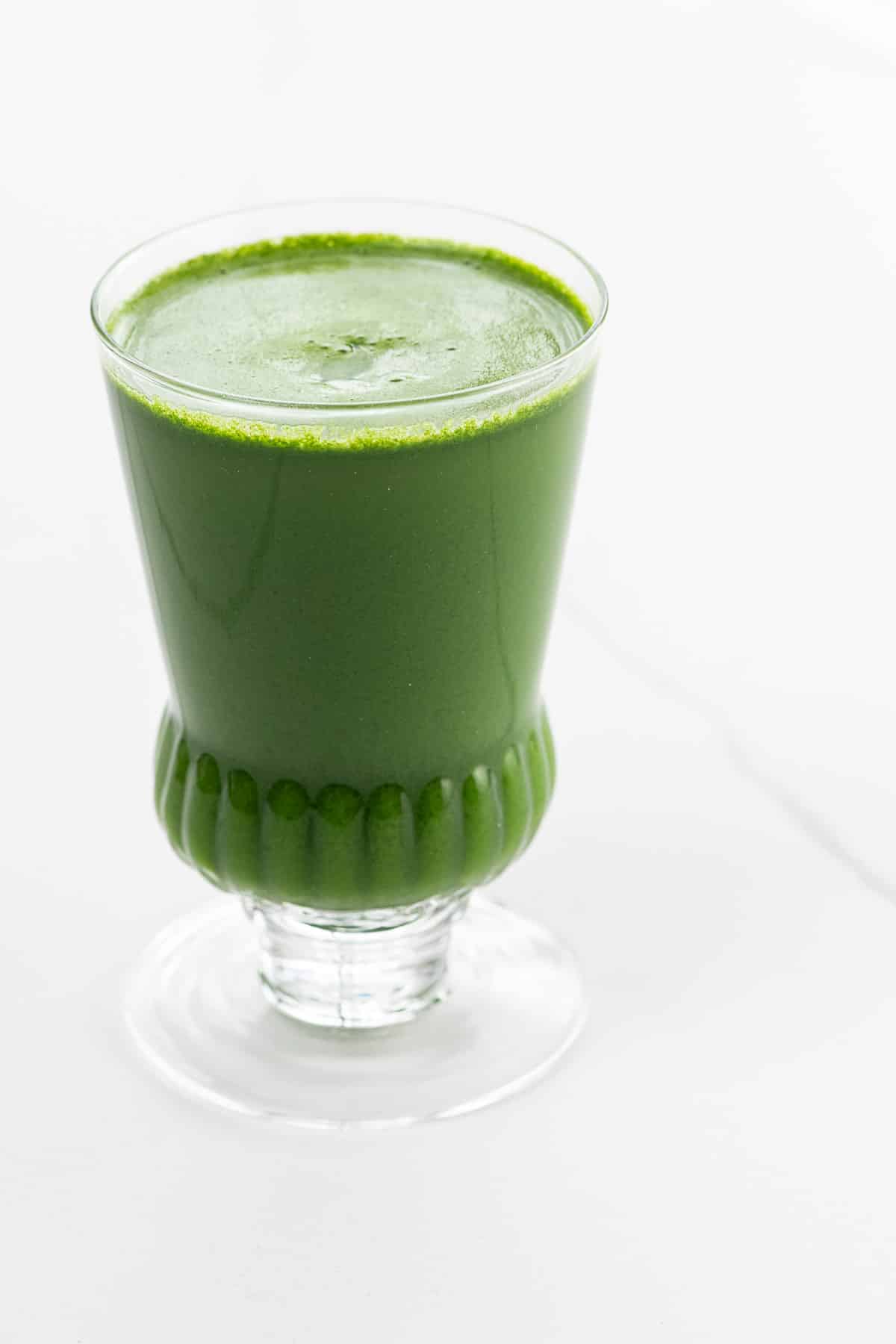
Hungry for more?
Subscribe to Umami Girl’s email updates, and follow along on Instagram.
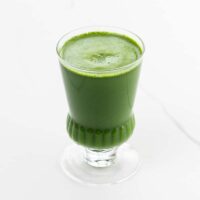
Kale Juice
Ingredients
- 2 large leaves curly kale, including stems
- ½ packed cup, (14 grams) cilantro leaves and stems
- 1 4- inch piece English or Persian cucumber
- 1/2- inch piece ginger
- 1 lime, peel and pith removed
- 1 small green apple
- 2 ribs celery, including any leaves
Instructions
- Feed all ingredients through juicer in the order listed.
- Stir well and strain through a fine-mesh sieve.
- Pour into a glass and serve.
Notes
- Green curly kale tends to have a fairly mild flavor, and it produces quite a bit of juice. You'll use two large leaves, including the stems.
- Cilantro has a lot of health benefits and also packs a flavor punch. I love what it adds to this juice. If you don't like it, you can substitute parsley.
- Cucumber is an easy choice for juicing. I like to use unwaxed varieties so I can include the skin. English and Persian cucumbers are good bets, as in anything from the garden or farmers' market.
- Ginger is a great inflammation-buster and adds a fiery freshness to the flavor profile. If you're not a fan, you can leave it out.
- Lime adds an element of tanginess and freshness. You'll use a knife to cut off the peel and white pith and then put the rest of it through the juicer.
- A tart green apple (such as Granny Smith) is one of my favorite green juice ingredients. It adds a bit of complex sweetness and tartness that complements virtually all juices, while keeping things relatively low-glycemic. You don't need to peel it. The rest of the prep depends on your juicer — see manufacturer's instructions for best results.
- Celery is an absolute workhorse of green juice. It has a mild, pleasant flavor and contributes a ton of volume. Put it through the juicer last to flush out any remaining goodness from the other fruits and veggies.
- I use the Kuvings Whole Slow Juicer, a masticating juicer that juices pretty efficiently and preserves nutrients for a longer period than centrifugal juicers. You can make this recipe with any juicer.
- The nutrient retention in fresh juice has a lot to do with what kind of juicer you're using. If you have a centrifugal juicer, it's best to drink your juice fairly soon after you make it. With a masticating juicer, feel free to juice in larger batches. They'll keep well in an airtight container in the fridge (such as a quart-sized mason jar) for two to three days.
- Juice can be frozen for longer storage, but you'll find that any remaining solid bits fall out of suspension and sink to the bottom after defrosting. I'm not personally a huge fan of the texture of defrosted juice, but if you're okay with it, freezing can be a good bet.
Nutrition
Nutrition information is automatically calculated, so should only be used as an approximation.
Hungry for more?
Subscribe to Umami Girl’s email updates, and follow along on Instagram.

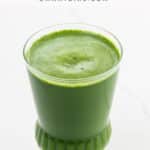
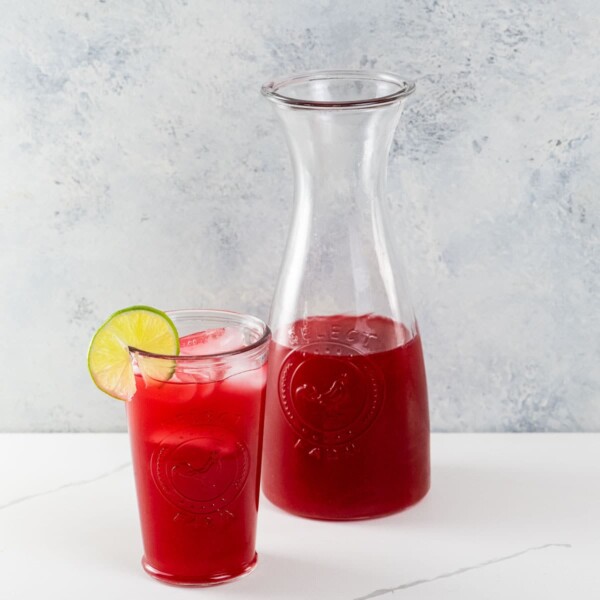
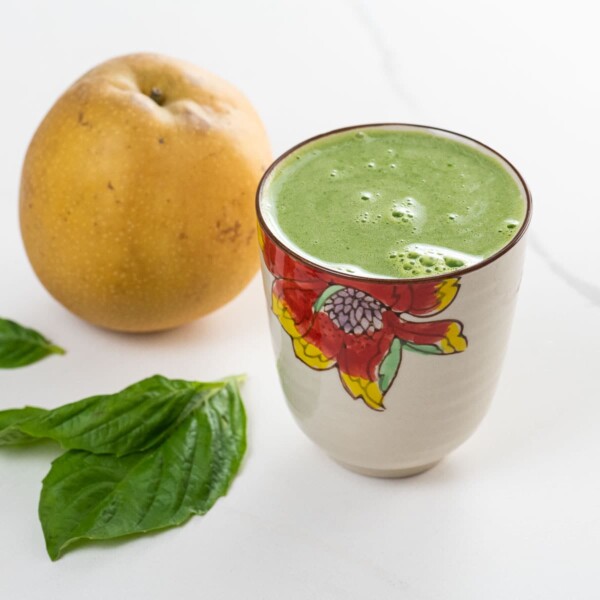
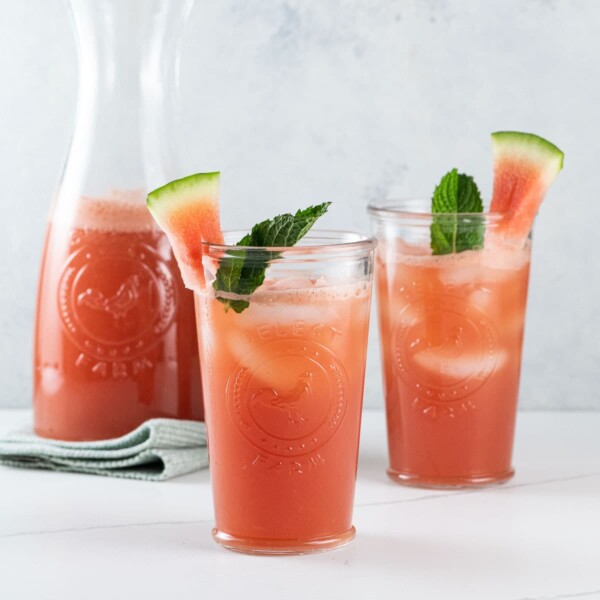
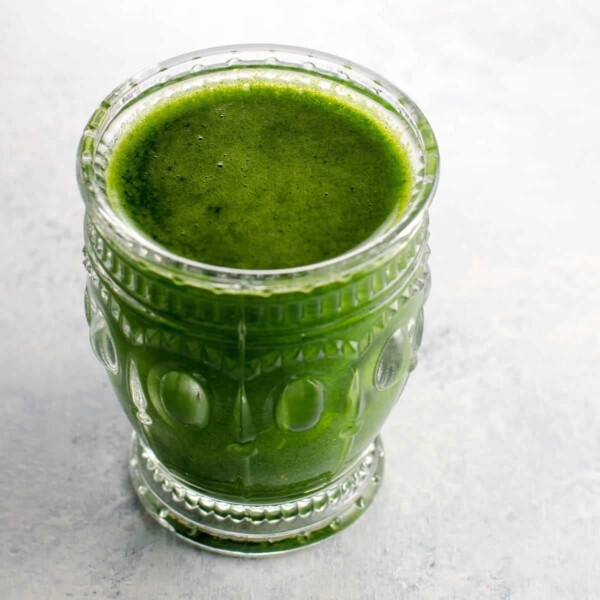







Glad to be here,thanks for sharing this.I’ll sure try it. =)
A number of my friends have started going ‘green’ in their morning routine as well.
I will have to admit, the idea of green slime, and memories of Soylent Green, all have me keeping the lip of the glass from ever touching my own lips.
One morning, about a month ago, while at the home of one of those friends, I was there during their daily slime fest. Betsy kept insisting I should try it to the point of finally breaking through, and I took the plunge – it was a weak moment of resistance to be sure!
Simply, I was stunned at just how good it was!
One of my problems with the juicing movement, is that there’s no mastication taking place – what is food without mastication! I also love the ability to have clearer taste definition of the food elements.
So while I will say I’ve survived, even enjoyed the initiation, I’m not likely to make the switch any time soon – I love my commercial range far too much for that.
I love green juice but I have to admit I get lazy sometime and just don’t take out juice.. BAd me..
You have just inspired me… I so need to get back on track!
Due to health concerns, I’ve begun to take a serious look at my diet. Been thinking of getting a juicer to help shift from colas to juices of nature. Thanks for posting your recipe, it has been an inspirational help.